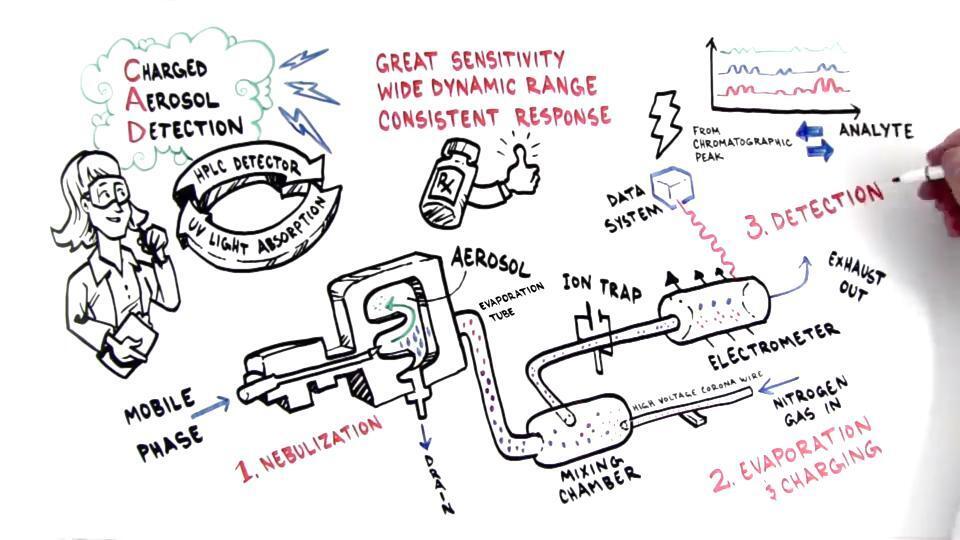Search Thermo Fisher Scientific

Vanquish Inverse Gradient LC Systems
Improve your lab's quantification capabilities with the Thermo Scientific Vanquish Inverse Gradient LC Systems, employing the unique and universal Charged Aerosol Detection, to consistently quantify all non-volatile and semi-volatile compounds even when no reference standard is available.
Highlights
Universal detection
Vanquish Inverse Gradient LC Systems use the unique and versatile Charged Aerosol Detector (CAD), a universal detector for the sensitive measurement of non- and semi-volatile compounds – from small molecule to biomolecules, foods and beverages, specialty chemicals or polymers.
Uniform response for gradient elution
Changing organic composition over a gradient elution results in fluctuation in analyte response. Post column application of an inverse gradient compensation eliminates this effect by ensuring the eluent entering the detector always has the same solvent composition regardless of where the compound elutes during the gradient separation.
Standard-free quantification
Consistent detector response means that unknown substances can be quantified, even if you lack an individual standard of a specific compound.
Simplified method setup
Effortlessly apply an inverse gradient with Thermo Scientific Chromeleon Chromatography Data System (CDS) wizards that take all system volumes into account and automatically calculate all required parameters for you.
Easy and reliable tool-free connections
The fluidic pathway of the Vanquish Inverse Gradient LC Systems are fitted with Thermo Scientific Viper Fingertight Fittings, which support near-zero dead volume connections and enable sharper peaks and tool-free setup.
CDS software
The Vanquish Inverse Gradient LC Systems seamlessly integrate with our Chromeleon CDS software to deliver superior compliance tools, networking capabilities, automation and data processing.
What is inverse gradient liquid chromatography?
The inverse gradient system allows you to consistently quantify all non-volatile and semi-volatile compounds using universal Charged Aerosol Detection.
Quantification recovery of unknown compounds
For a gradient separation, the quantification recovery of unknown compounds with CAD is best with the eluting conditions from the Inverse Gradient approach. For a standard CAD, the quantification recovery will depend on the organic content. UV detection recovery depends on extinction coefficient of the analyte.
Videos
System specifications
The table below provides an overview of the Vanquish Inverse Gradient LC Systems specifications for a standard setup. Not all specifications are listed. Your specifications may differ based on the components of your system. Find the specification sheets for the system components in the Component specifications, below.
| Category | Vanquish Inverse Gradient LC Systems |
| System pressure, maximum | 700, 1000 or 1500 bar, depends on system configuration |
| Flow range | 0-5, 0-8, 0-10 mL/min, depends on system configuration |
| Pump options (default gradient delay volume) | Binary (35, 200, or 400 µL) Quaternary (679 µL) Dual (679 µL) Delay volume depends on pump(s) selected |
| Biocompatible | Yes, depends on system configuration |
| pH range | 2–12, chloride concentration up to 1 mol/L
|
| System design | Modular |
| Touchscreen user interface display compatible (optional) | Yes, depends on system configuration |
| Solvent monitoring system compatible (optional) | Yes, depends on system configuration |
| Customizable gradient delay volume to simplify method transfer | Yes, depends on system configuration |
| SmartInject technology for maximum injection precision and improved column lifetime | Yes |
| Injection volume range | Standard: Up to 0.01-25 or 0.01-100 µL (Vanquish Flex/Vanquish Horizon) |
| Sample cooling | Yes, 4-40°C Depends on sampler selected |
Sample capacity (standard) Based on standard 12 mm OD vials |
4 racks of 54 vials (≤ 1.5mL) each, other rack formats available + capacity of 12 x 22.5 mm OD vials (≤ 10 mL) in the carousel |
| Sampler extension available (optional) | Yes, with Vanquish Charger |
| Column compartment thermostatting | Yes, 5-120°C, depends on system configuration Still air and forced air |
| Column compartment pre-heater | Active and passive Depends on system configuration |
| Column compartment post-column cooler | Yes Depends on column compartment selected |
| Detector choices | Vanquish Charged Aerosol Detector Vanquish Variable Wavelength Detector |
Component specifications
Standard Vanquish Duo HPLC and UHPLC Systems for Inverse Gradient LC are made up of the following components. More detail is available below.
| Vanquish Horizon UHPLC System | Vanquish Flex Inverse Gradient UHPLC System | Vanquish Core Inverse Gradient HPLC System | |
Pump
|
2 Vanquish Binary Pump H | 2 Vanquish Binary Pump F or 2 Vanquish Quaternary Pump F or 1 Vanquish Dual Pump F |
2 Vanquish Binary Pump C/CN or 2 Vanquish Quaternary Pump C/CN or 1 Vanquish Dual Pump C/CN |
Autosampler
|
Vanquish Split Sampler HT | Vanquish Split Sampler FT | Vanquish Split Sampler C or Vanquish Split Sampler CT |
Extended sample capacity (optional)
|
Vanquish Charger (optional) |
||
Column compartment
|
Vanquish Column Compartment H | Vanquish Column Compartment C | |
Virtually zero dead volume system connections
|
Viper UHPLC Fittings Kits | ||
Detectors
|
For additional detectors, visit our HPLC and UHPLC Detectors page |
||
For Research Use Only. Not for use in diagnostic procedures.
